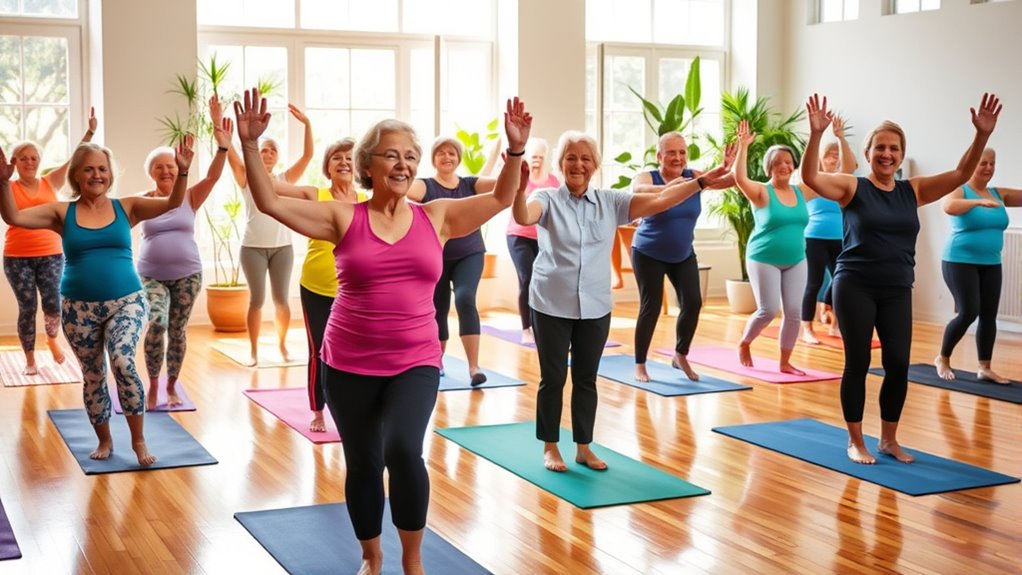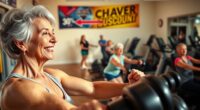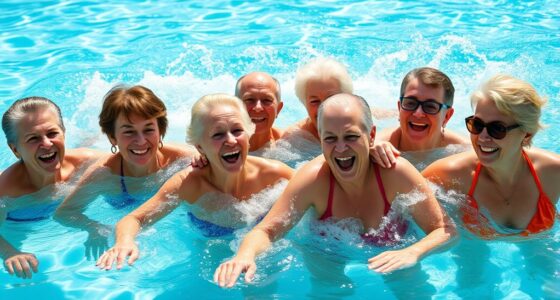Exercise can truly revolutionize your routine as a senior. It boosts heart health, strengthens muscles, and improves balance, all while reducing the risk of chronic diseases. Aim for at least 150 minutes of moderate activity each week and include strength training twice a week. Activities like walking, swimming, and group classes not only keep you fit but also foster social connections. Want to discover more ways to stay active and engaged? There’s so much more to explore!
Key Takeaways
- Incorporate at least 150 minutes of moderate-intensity aerobic activities weekly to boost heart health and overall fitness.
- Engage in strength training twice a week to maintain muscle mass and independence as you age.
- Practice balance exercises three times a week to significantly reduce fall risk and enhance stability.
- Join community fitness classes for social interaction, motivation, and accountability in your exercise routine.
- Explore online fitness options like SilverSneakers LIVE for flexibility and access to various workouts from home.
Health Benefits of Exercise for Seniors

When you engage in regular exercise, you’re not just keeping fit; you’re actively reducing your risk of chronic diseases like heart disease and diabetes. Additionally, good grief can be supported by staying physically active, as regular exercise can help alleviate symptoms of anxiety and depression, promoting emotional well-being during challenging times. Engaging in physical activity also aligns with the principles of gout nutrition, which emphasizes the importance of a balanced lifestyle for overall health. Moreover, cultivating a bias to action can motivate seniors to incorporate exercise into their daily routines, enhancing their overall quality of life. Furthermore, engaging in regular physical activity can help maintain equitable distribution of muscle mass and strength, which is vital for overall mobility and independence.
The health benefits of exercise extend beyond physical fitness, promoting overall cardiovascular health and improving balance. Engaging in physical activity enhances muscle strength and bone density, which is essential for preventing falls, a leading cause of injury among seniors. Additionally, exercise can greatly boost cognitive function, potentially reducing the risk of Alzheimer’s disease by nearly 50%. You’ll also enjoy better sleep quality and increased energy levels, contributing to a more active lifestyle. Regular participation in group exercises can create social connections that improve mental health, helping you feel more connected and less isolated in your community.
Recommended Exercise Frequency for Seniors
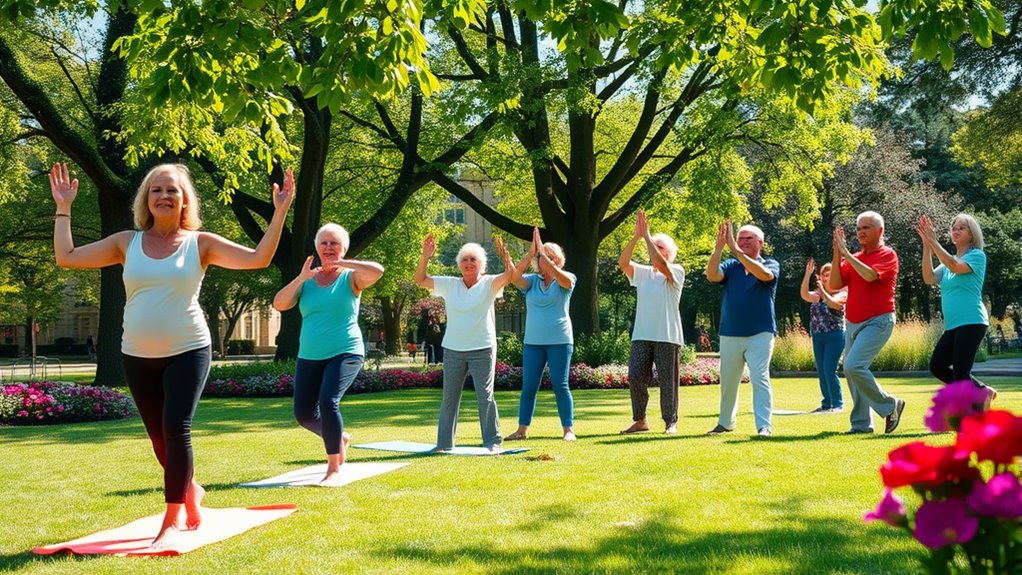
Seniors should aim for at least 150 minutes of moderate-intensity aerobic activity each week to maintain ideal health. You can break this down into shorter sessions of 10 to 15 minutes, making it easier to stick to your exercise regimen. Engaging in regular physical activity can also boost your overall wellness and mental health, contributing to improved emotional well-being through organized environments. Additionally, understanding financial considerations for ongoing care can help seniors prioritize their health and fitness. Regular monitoring of production quantity variance in exercise routines can help ensure that physical activity remains effective and aligned with health goals.
Alternatively, engaging in 75 minutes of vigorous-intensity activity weekly also works, depending on your fitness levels. It’s essential to include at least two days of muscle-strengthening activities to improve overall strength and maintain muscle mass. Don’t forget to incorporate balance improvement activities into your routine; practicing these three times a week is crucial for fall prevention. Additionally, it’s important to consider that critical periods in life can influence how seniors respond to physical activity and exercise routines.
Remember to adjust your exercise frequency and intensity based on your abilities and any chronic conditions to guarantee safety and effectiveness in promoting health and wellness.
Importance of Balance and Stability Exercises

As you age, maintaining balance and stability becomes increasingly important to prevent falls, which affect one in four older Americans each year. Engaging in balance exercises can reduce your risk of falls by 23%, greatly improving your overall stability and coordination. Additionally, creating enhanced living spaces that support mobility can play a crucial role in your safety and comfort at home. Incorporating features such as non-slip surfaces can further enhance stability in your living environment. Furthermore, regular exercise can also contribute to emotional well-being by alleviating symptoms of anxiety and depression. Additionally, emotional regulation is essential, as it influences your ability to cope with the challenges of aging.
To effectively enhance balance, aim to practice stability exercises three times a week. Simple movements, like single-leg balances and weight shifting, can be done daily to strengthen your muscles and improve proprioception, key factors in maintaining balance.
Incorporating these exercises into your routine not only boosts your physical stability but also increases your confidence. This enables you to participate more fully in daily activities and reduces the fear of falling, allowing you to enjoy life to the fullest. Additionally, engaging in regular exercise can improve your respiratory health, further enhancing your overall well-being.
Strength Training for Seniors
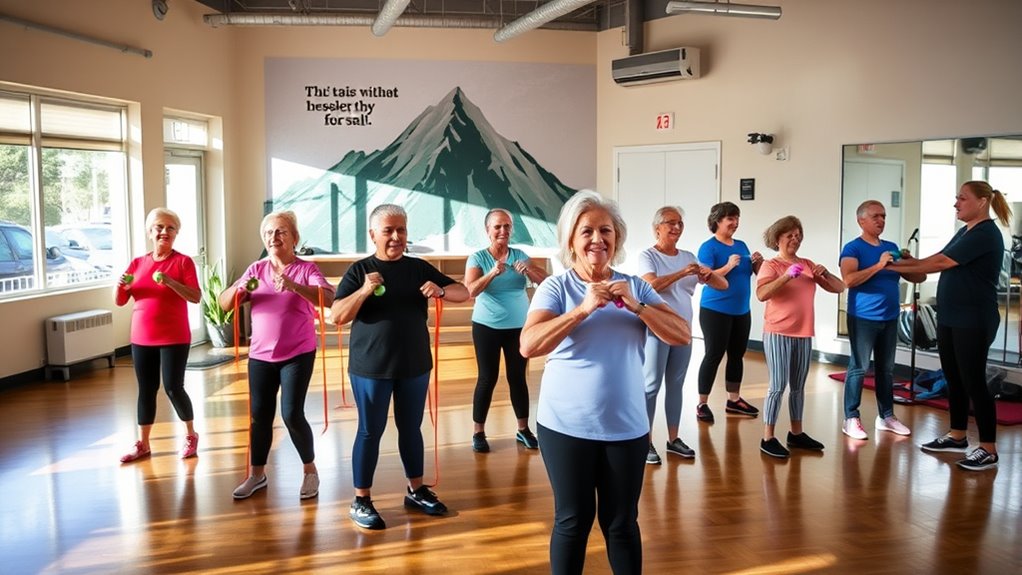
Strength training is essential for you as a senior, helping to prevent muscle loss and maintain your independence. By incorporating exercises like chair squats and wall push-ups into your routine, you can build strength safely and effectively. Additionally, engaging in interactive play can enhance your overall well-being by promoting social interaction and cognitive engagement. Regular strength training can also improve self-care practices, ensuring you prioritize your physical health as you age. Plus, using resistance bands can offer a low-risk way to enhance your muscle mass and improve your balance. Additionally, whole foods can complement your exercise regimen by providing the necessary nutrients for recovery and energy. Regular strength training not only builds muscle but also contributes to overall health, making it crucial for maintaining vitality as you age. Incorporating physical activity into your daily routine can further enhance your strength training efforts and promote better sleep.
Benefits of Strength Training
Engaging in strength training offers numerous benefits that can greatly enhance your quality of life as you age. By incorporating strength training into your routine, you can improve strength, muscle strength, and balance, making daily activities easier and safer. Regular sessions also promote better physical health and bone density, reducing the risk of osteoporosis. Additionally, strength training is an effective method for boosting mental health by alleviating symptoms of depression and anxiety. Regular exercise can also improve indoor air quality, leading to a healthier living environment. Furthermore, engaging in physical activity can enhance respiratory function, which is particularly beneficial for seniors. Aim for at least two sessions a week to enjoy these advantages. Additionally, the development of emotional intelligence can further enhance your overall well-being and social interactions.
| Benefits | Impact |
|---|---|
| Improve Strength | Easier daily activities |
| Enhanced Balance | Reduced fall risk |
| Increased Muscle Strength | Better overall mobility |
| Boosted Mental Health | Decreased anxiety symptoms |
Effective Exercises for Seniors
Building on the benefits of strength training, it’s important to know which exercises can be most effective for seniors. Wall push-ups and chair squats are excellent exercises for seniors, helping to maintain strength and stability.
Aim for at least two days of muscle-strengthening activities each week to improve muscle strength and support mobility. Resistance bands are a fantastic option, providing a safe way to build strength without heavy weights.
Bodyweight exercises like knee extensions and pelvic tilts can be done at home, promoting independence in daily tasks. Regularly incorporating these effective exercises for seniors can greatly improve balance and coordination, reducing the risk of falls and enhancing your overall quality of life.
Low-Impact and Cardiovascular Exercise Options
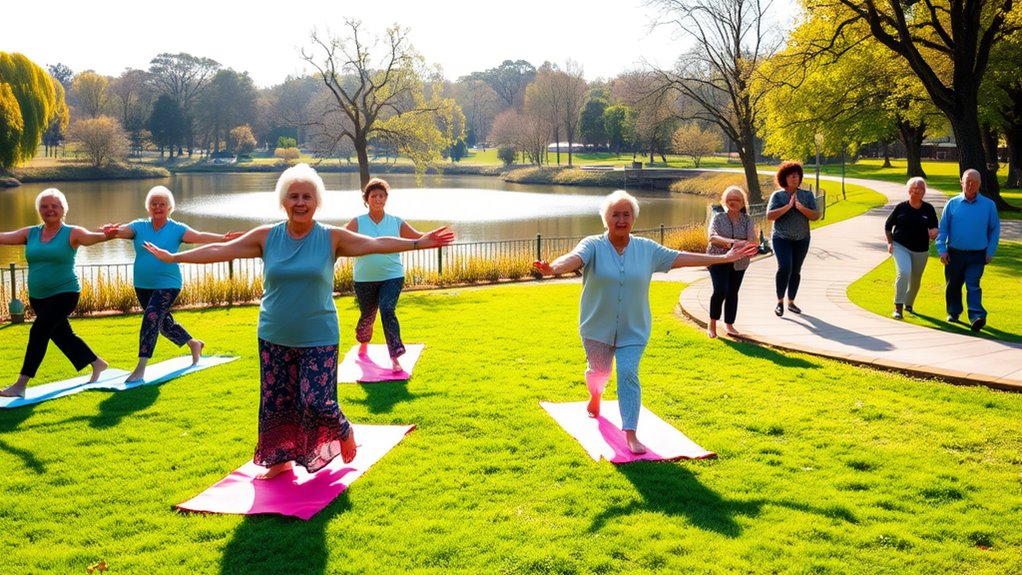
When it comes to staying active, low-impact activities can be both enjoyable and effective for your cardiovascular health.
Options like swimming, cycling, and walking not only reduce stress on your joints but also keep your heart strong.
Enjoyable Activities for Seniors
Exercise can be an enjoyable part of life for seniors, especially when it involves low-impact and cardiovascular options. Engaging in enjoyable activities for seniors, like brisk walking or cycling, can greatly improve cardiovascular health while being gentle on your joints.
Water aerobics classes, such as those offered through SilverSneakers, provide a supportive environment that enhances strength without the strain of traditional workouts. Joining group fitness classes, like Zumba Gold or line dancing, not only keeps you active but also fosters community connections.
Effective Cardiovascular Workouts
Many seniors find that effective cardiovascular workouts can be both invigorating and accessible. Low-impact exercises like swimming, cycling, and walking are ideal for improving your heart health and stamina without risking injury.
Water aerobics, for example, enhances muscle strength and flexibility while being gentle on joints. Aim for at least 150 minutes of moderate-intensity aerobic activity weekly to lower your risk of chronic diseases and boost your overall quality of life.
Incorporating short, frequent sessions—like 5-minute walking intervals—can help you meet your activity goals without feeling overwhelmed. Engaging in enjoyable cardiovascular activities not only improves your physical health but also fosters social connections, enhancing your mental well-being as a senior.
Mobility Exercises for Daily Independence

To maintain your daily independence, incorporating mobility exercises into your routine is essential.
These exercises help you retain the agility and flexibility needed for everyday tasks, allowing you to move with greater ease. By dedicating just 15 minutes a day to gentle stretching and movement, you can markedly improve your movement efficiency and enhance your overall comfort, promoting a more active lifestyle.
Regularly practicing mobility routines also improves your balance and coordination, which are vital for fall prevention. Consistency in these exercises not only supports your physical health but also boosts your mental well-being, fostering a sense of accomplishment and confidence in your daily movements.
Embrace mobility exercises to empower your independence and sustain a vibrant life.
Flexibility Exercises for Neck, Shoulders, and Ankles

To keep your neck, shoulders, and ankles flexible, try incorporating some simple stretches into your daily routine.
Neck tilts and shoulder rolls can ease tension and enhance mobility, while ankle circles boost strength and balance.
These exercises not only help with flexibility but also make everyday activities much easier.
Neck Stretch Techniques
As you age, maintaining flexibility in your neck and shoulders becomes essential for overall mobility and comfort. Incorporating neck stretches into your routine can greatly relieve tension and improve mobility. Gently tilt your head side to side, holding each stretch for 15-30 seconds, and repeat 3-5 times. Don’t forget upper back stretches; extend your arms forward and reach your fingertips out, holding for 10-30 seconds. Shoulder rolls, where you rotate your shoulders up to the ceiling and back down, are also effective for reducing stiffness.
| Exercise Type | Duration | Repetitions |
|---|---|---|
| Neck Stretches | 15-30 seconds | 3-5 times |
| Upper Back Stretches | 10-30 seconds | 3-5 times |
| Shoulder Rolls | 5 rotations in each direction | 3-5 times |
Shoulder Mobility Exercises
Maintaining flexibility in your shoulders is just as important as keeping your neck and upper back limber. Shoulder mobility exercises, like shoulder rolls and arm cross stretches, help improve flexibility and reduce stiffness in your shoulder joints. This is essential for maintaining your range of motion as you age.
Regularly practicing these stretches enhances upper body mobility, making daily activities like reaching and lifting easier, promoting your independence. Engaging in shoulder mobility exercises alleviates tension and discomfort, contributing to your overall well-being.
Plus, incorporating these stretches into your routine can improve posture and alignment, preventing issues like rounded shoulders. Consistent practice also strengthens muscles and stability in your shoulder girdle, reducing injury risk and enhancing overall physical function.
Ankle Flexibility Movements
While it’s easy to overlook ankle flexibility, incorporating specific movements into your routine can greatly enhance your mobility and balance.
Engaging in ankle rotations and flexion and extension exercises helps improve strength and stability, which are essential for preventing falls. These movements also enhance circulation and reduce stiffness, making daily activities more comfortable.
By regularly practicing these ankle flexibility movements, you can alleviate discomfort from conditions like arthritis, common among seniors. Improved ankle flexibility not only supports better performance in walking and climbing stairs but also boosts your overall functional ability.
As a result, you’ll enjoy a more active lifestyle and greater independence in your daily tasks. Prioritize your ankle health for better mobility and confidence!
Short Cardio Sessions for Quick Energy Boosts

If you’re looking for a quick energy boost, short cardio sessions can be a game-changer. Incorporating brief bursts of activity, like 5-minute sit and stand exercises, can effectively boost energy levels and elevate your heart rate.
These quick sessions not only enhance cardiovascular health but also fit easily into your daily routine, especially for those with limited mobility. You don’t need much space or equipment to get started.
Aim to perform these short cardio sessions multiple times a day; they can notably improve your overall well-being and combat feelings of fatigue. Research shows that even small intervals of cardio can elevate your mood, promoting a more active lifestyle.
Senior-Friendly Workouts and Group Exercises

Short cardio sessions can energize your day, but adding senior-friendly workouts and group exercises can take your fitness journey to the next level.
Participating in group fitness classes like Zumba Gold or SilverSneakers Classic offers low-impact exercises tailored for older adults. These classes not only boost your activity levels but also provide essential social interaction, reducing feelings of isolation.
Group fitness classes like Zumba Gold and SilverSneakers Classic offer low-impact exercises and vital social interaction for older adults.
Engaging in community fitness activities at local gyms or centers fosters friendships and support among peers.
If you prefer working out at home, online options such as SilverSneakers LIVE give you the flexibility to join group classes from your living room.
Embrace these opportunities to make your fitness routine enjoyable and connected!
Embracing Lifelong Fitness for Overall Well-Being
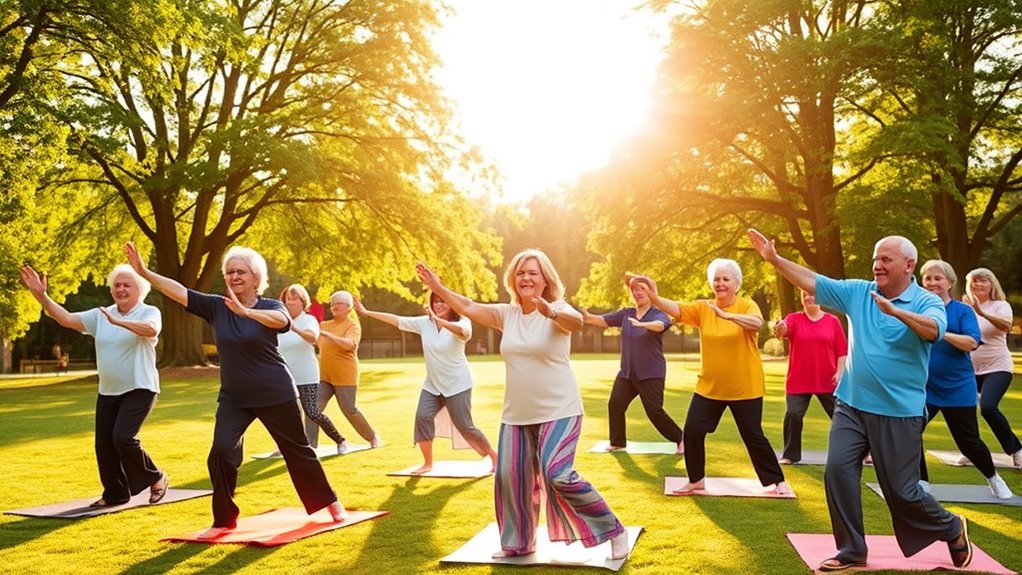
Embracing lifelong fitness not only keeps you physically active but also greatly boosts your overall well-being. Regular exercise plays an essential role in your life, enhancing mental health and overall vitality. Just 30 minutes a day can elevate your mood and sharpen cognitive function, while strength training and balance exercises improve your stability. This combination can reduce the risk of falls by 23%, ensuring your mobility and independence.
| Benefits | Details |
|---|---|
| Regular Exercise | Lowers risk of Alzheimer’s by 50% |
| Mental Health | Reduces depression and anxiety |
| Improves Balance | Enhances stability and confidence |
| Builds Strength | Increases energy and combats fatigue |
| Overall Well-Being | Promotes active social engagement |
Stay active, and enjoy the many rewards of a fit lifestyle!
Frequently Asked Questions
What Is the Number One Exercise for Seniors?
The number one exercise for seniors is walking. It’s low-impact, easy to fit into your daily routine, and can greatly boost your cardiovascular health.
Aiming for 10,000 steps a day can lower your mortality risk by an impressive 46%. You can break your walks into shorter sessions of 10 to 15 minutes, making it manageable.
Plus, walking enhances not just your physical health but your mood and mental well-being, too!
What Is the Number 1 Exercise to Increase Balance in Seniors?
To increase balance, the single limb stance exercise is your best bet. Stand on one leg, keeping the other leg lifted and your body steady.
Aim to hold this position for up to one minute on each side. As you practice, you’ll enhance your stability and coordination, reducing the risk of falls.
Gradually increase your hold time as your balance improves, and enjoy greater confidence in your daily activities.
What Is the 5 5 5 30 Exercise?
Imagine your body as a well-tuned orchestra, each section playing its part in harmony.
The 5 5 5 30 exercise routine conducts this symphony beautifully. You spend five minutes on strength training, five on flexibility, and five on balance, followed by a 30-minute aerobic session.
This balanced approach not only enhances your overall fitness but also builds confidence, improves mobility, and reduces chronic disease risk, making your daily activities feel like a graceful dance.
Which Type of Exercise Is Most Strongly Recommended for Older Adults?
For older adults, a combination of moderate aerobic activities, strength training, and balance exercises is most strongly recommended.
Aim for at least 150 minutes of moderate-intensity activity each week to boost your overall health.
Incorporate strength exercises, like wall push-ups and chair squats, at least twice a week to preserve muscle and bone mass.
Don’t forget balance exercises, like tai chi, to help prevent falls and maintain your independence as you age.
Conclusion
Embracing exercise as a senior is like tending to a garden; with care and consistency, it flourishes, bringing energy and joy to your life. By incorporating balance, strength, and flexibility into your routine, you’re not just enhancing your health, but also nurturing your overall well-being. So, grab a friend, try out those recommended exercises, and watch as your energy and confidence bloom. Remember, it’s never too late to start reaping the rewards of an active lifestyle!

